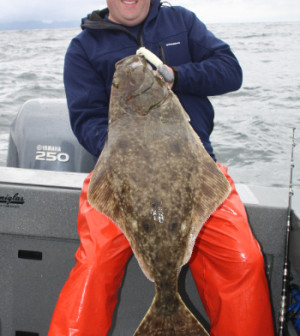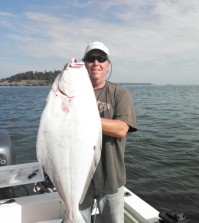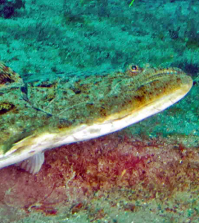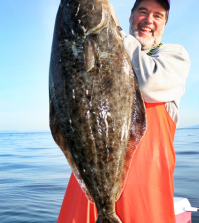Heavy Metal Halibut

I’ve never really kept records of what baits and lures I used to catch halibut, but it’s a safe bet that I’ve caught more of them and the highest percentage of really big ones on jigs, either leadheads or metal, slab-type jigs. My largest halibut ever-a 225-pounder from Southeast Alaska’s Chatham Strait–inhaled a large Crippled Herring jig the instant it hit bottom on a 125-foot hump where I had been fishing bait for nearly two hours without even a touch.
I’ve been asked many times over the years what I would choose if I had to pick just one bait or lure for all my halibut fishing. Although my choice of brand, size and color might be hard to nail down, the lure type would be easy to select: a metal jig. Also called slab jigs, metal jigs are the size and shape of the herring, anchovies, candlefish and other little bundles of protein that halibut, salmon and most other marine sport fish like to gorge on.
The metal slab, though, is only one of two jig types that will catch halibut consistently. Leadheads rigged with plastic grub tails are also proven halibut-getters, so if we’re going to talk about one here, we might as well discuss them both.
Although both slab jigs and leadheads will take fish wherever you may choose to use them, catching halibut on jigs isn’t a simple matter of tying one to the end of your line and filling the fish box. Using the right jig at the right time, and fishing that jig as actively as necessary, make the difference between a good day of halibut fishing and just another day on the water.
The primary rule in picking the “right” jig is picking one that’s heavy enough to reach bottom and stay there under whatever conditions you’re fishing. A 5- or 6-ounce jig may be heavy enough if you’re fishing along the 20-fathom line near Green Point on a gentle tide with no wind, but you may need a jig three or four times as heavy if you’re trying to fish down a 200- to 350-foot slope on a moderate ebb. If you can’t keep your jig close to bottom without constantly paying out line in 20-foot spurts, your jig is too light for the conditions. The need for jigs of various sizes, all the way up to two pounds or better, is what makes Northwest halibut anglers’ tackle boxes so damn heavy!
Jig color runs a distant second to jig weight in terms of importance, as far as I’m concerned. Yeah, I like the looks of those realistic-looking slab jig finishes with dark backs, white bellies and lots of shiny milar in between just as much as anybody does, but I’ve caught a lot more halibut on plain ol’ white jigs than I have on all other finishes and colors combined. I’m convinced that’s because white reflects light and stays visible at greater depths than any other color, and visibility is one of the factors that determines whether or not a hungry halibut can find your jig.
Scent also plays a big part in how well a halibut can find your lure, and there are several ways to make your jig smell more like a full-meal deal to nearby halibut. The most obvious is to add Smelly Jelly, Pautzke’s Gel-Krill or one of the other gel-type scents directly to your jig, and that technique certainly works. Just smear a little of the stuff along both sides of the jig and let ‘er go. And I don’t think the “flavor” you use makes all that much difference; the main thing is to make your jig smell like something other than a slab of metal or ball of lead and plastic.
Remember, too, that some jigs come already equipped with scent. Berkley’s 8-inch PowerBait saltwater grub may carry the aroma of dirty socks when they first come out of the package, but attached to a leadhead jig and dropped into the depths they must smell like fillet mignon to a hungry halibut, because they sure do work!
Besides the “artificial” scents that come out of a jar or package, you can also enhance the effectiveness of your jigs by adding real bait to it in any of several ways. Tougher baits, like a strip of halibut skin, salmon belly or squid, can be added directly to the hook of a metal jig. I like to run the hook through these baits only once, near the top end, so that they wiggle and wave like a tail at the end of the lure as it’s worked up and down through the water.
Another way to get the benefit of natural-smelling bait while you jig is to run a short teaser leader off your line a couple of feet above the jig, tie an un-weighted hook to the end of the teaser and fish bait on that teaser hook. Again, tougher baits work best here, but you may also experiment with whole herring, anchovies or other small baitfish on those teaser rigs as well.
Teasers, by the way, will increase the effectiveness of your jigs even if you use curly-tail grubs, pork rind or other artificials on the teaser hook rather than bait. Having that added flash and wiggle a couple of feet above the main lure greatly increases the visibility of your rig, attracting more fish from greater distances than the single lure bouncing along the bottom would attract.
Which brings us to the third sense that halibut use to find your bait or lure: sound. No, halibut don’t have ears, but like other fish they have that lateral line running down their sides, and it picks up vibrations through the water in much the same way our eardrums pick up vibrations through the air. Halibut may “hear” a smaller fish, crab or other potential meal scuttling or fluttering along the bottom and move in to take a closer look, and jiggers can capitalize on that tendency by bouncing their jigs along the bottom to create a little ruckus. If your jig never touches the bottom, you won’t be creating that bottom-pounding sound that might serve as a halibut dinner bell under at least some circumstances. Besides, if you aren’t pounding bottom regularly, there’s a good chance you’re fishing too shallow and aren’t even in the strike zone of most of the halibut down there. As with jigging for salmon, there’s no such thing as the perfect jigging stroke for halibut. Generally speaking, the deeper you’re fishing, the longer jigging strokes you’ll want to take, but there are times when the fish get lazy and simply won’t bother swimming three or four feet off the bottom to take a lure. At those times, a short stroke works best, so the key is usually to experiment with longer and shorter strokes until you find what’s working. Just remember to keep it bouncing along the bottom, no matter how far you’re lifting it. Remember, too, that you’ll usually have to work a metal, slab-type jig harder than a leadhead/grub combo, because the grub tail is much livelier and has a lot more built-in wiggle than a metal jig. I’ve hooked a few halibut on leadheads while the rod was in the holder, but that hardly ever happens with a slab jig unless it’s adorned with a lively tail or fished in conjunction with bait or a teaser.










